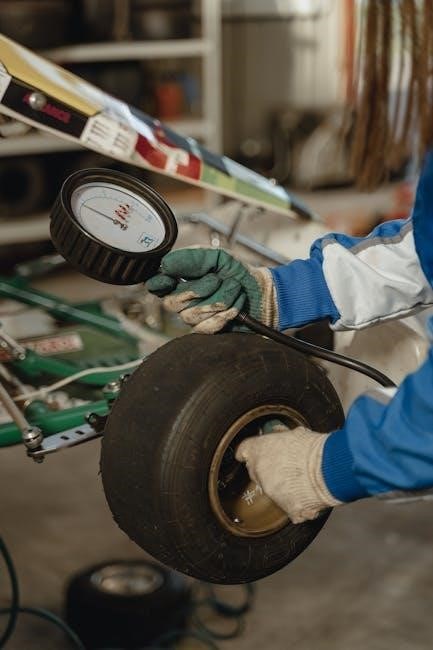Proper tire inflation is crucial for John Deere tractors, and a tire pressure chart PDF provides essential information for optimal performance and safety, including recommended pressures and guidelines for various models and applications always․
Importance of Correct Tire Pressure
Correct tire pressure is vital for the overall performance and safety of John Deere tractors, as it affects traction, fuel efficiency, and equipment longevity․ Properly inflated tires ensure a uniform and level cut, while underinflated tires can lead to uneven cuts and reduced productivity․ Additionally, correct tire pressure helps to prevent tire damage, reduces the risk of tire explosions, and improves the overall handling and stability of the tractor․ The importance of correct tire pressure cannot be overstated, as it has a direct impact on the tractor’s ability to function efficiently and effectively․ By maintaining the recommended tire pressure, operators can help to extend the life of their tires, reduce maintenance costs, and improve the overall performance of their John Deere tractor․ Furthermore, correct tire pressure is essential for ensuring the safety of the operator and bystanders, as underinflated tires can increase the risk of accidents and injuries․
Understanding Tire Pressure Recommendations
Tire pressure recommendations are typically provided by the manufacturer and can be found in the owner’s manual or on the tire information placard, always ensuring proper inflation for optimal performance and safety levels․
Factory Inflations and Manufacturer Information
Factory inflations and manufacturer information are crucial for determining the correct tire pressure for John Deere tractors․ The manufacturer’s recommendations can be found in the owner’s manual or on the tire information placard․ It is essential to follow these guidelines to ensure proper inflation and optimal performance․ The factory inflations are the standard pressures recommended by the manufacturer, and they may vary depending on the specific model and application․ Additionally, the tire manufacturer’s information should also be consulted, as they may have specific recommendations for their tires․ By following the manufacturer’s guidelines and using the correct tire pressure, operators can help prevent uneven tire wear, reduce the risk of tire failure, and improve the overall performance of their John Deere tractor․ The manufacturer’s information can be found on their website, in the owner’s manual, or by contacting a John Deere dealer directly․ This information is vital for ensuring the safe and proper operation of the tractor․

Tire Pressure for Front and Rear Tires
Front and rear tire pressures vary depending on the John Deere model and application, requiring specific guidelines for optimal performance and safety always with proper inflation․
Ag Tires and Loader Considerations
When using ag tires with a loader on a John Deere tractor, it is essential to consider the specific tire pressure recommendations to ensure optimal performance and safety․ The loader’s weight and the type of ag tires used can affect the recommended tire pressure․ According to the tire manufacturer’s information, the correct tire pressure for ag tires with a loader can vary depending on the specific application and model of the tractor․ It is crucial to consult the tire manufacturer’s guidelines and the John Deere dealer for specific recommendations․ Proper tire inflation can help prevent uneven tire wear, improve traction, and reduce the risk of tire failure․ Additionally, the type of ag tires used, such as bias ply or radial, can also impact the recommended tire pressure․ By following the recommended tire pressure guidelines for ag tires with a loader, operators can help ensure a safe and efficient operation․ This information is critical for farmers and agricultural workers who rely on their John Deere tractors for daily operations․

Consequences of Incorrect Tire Pressure
Incorrect tire pressure can lead to reduced traction, uneven wear, and increased risk of tire failure, compromising safety and performance of John Deere tractors and equipment always with serious consequences potentially․
Uneven Cut and Riding Lawn Equipment Performance
Proper tire pressure is essential for maintaining optimal performance of riding lawn equipment, as uneven tire pressure can result in an uneven cut, compromising the overall appearance of the lawn․
Tire pressure affects the stability and balance of the equipment, and incorrect pressure can lead to uneven wear on the tires, reducing their lifespan and increasing the risk of tire failure․
Additionally, uneven tire pressure can cause the equipment to pull to one side, making it difficult to maneuver and control, which can be frustrating for operators and compromise the quality of the cut․
It is crucial to check tire pressure regularly and ensure that it is at the recommended level, as specified in the John Deere tire pressure chart PDF, to maintain optimal performance and extend the life of the equipment and tires․
By maintaining proper tire pressure, operators can achieve a uniform, level cut and ensure that their riding lawn equipment performs at its best, providing a professional-looking finish and reducing the need for frequent maintenance and repairs․

Specific Tire Pressure Examples
John Deere tire pressure chart PDF provides examples for various models, including 4020LP and LX178, with specific pressure recommendations for front and rear tires, ensuring optimal performance and safety always․
John Deere Tractor Models and Tire Pressure Variations
John Deere tractor models have varying tire pressure requirements, and the chart PDF outlines these differences to ensure proper inflation․ The 4020LP and LX178 models, for example, have distinct pressure recommendations for front and rear tires․ The chart also accounts for factors such as tire size, type, and load capacity, providing a comprehensive guide for tractor owners․ Additionally, the chart includes information on tire pressure variations for different applications, such as agricultural and forestry use․ By consulting the chart, owners can determine the optimal tire pressure for their specific tractor model and operating conditions, promoting safe and efficient operation․ The chart’s detailed information enables owners to make informed decisions about tire inflation, reducing the risk of uneven wear, reduced traction, and other issues that can arise from improper tire pressure․ This ensures optimal performance and extends the lifespan of the tires․

